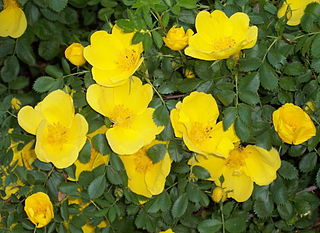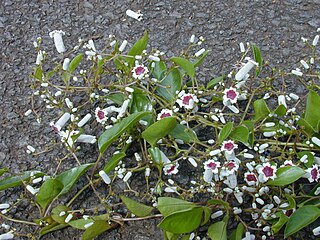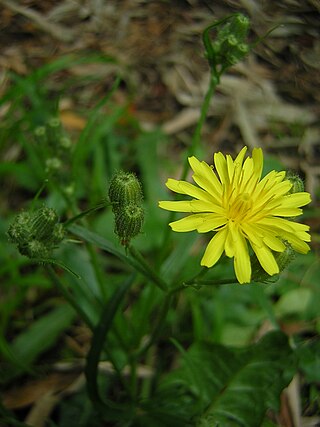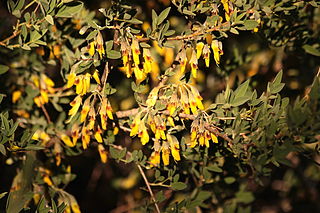
Asafoetida is the dried latex exuded from the rhizome or tap root of several species of Ferula, perennial herbs of the carrot family. It is produced in Iran, Afghanistan, Central Asia, northern India, and Northwest China (Xinjiang). Different regions have different botanical sources.

Passiflora foetida is a species of passion flower that is native to the southwestern United States, Mexico, the Caribbean, Central America, and much of South America. It has been introduced to tropical regions around the world, such as Southeast Asia, South Asia, Hawaii, Africa, and The Maldives. It is a creeping vine like other members of the genus, and yields an edible fruit. The specific epithet, foetida, means "stinking" in Latin and refers to the strong aroma emitted by damaged foliage.

Rosa foetida, known by several common names, including Austrian briar, Persian yellow rose, and Austrian copper rose, is a species of rose, native to the foothills of the Caucasus Mountains in Georgia. It has yellow flowers with a scent which some find objectionable. Since there were no yellow roses native to Europe, its introduction from Persia was an important addition to the cultivation of roses, and R. foetida is now an important contributor to the stock of cultivated roses.

Theosodon is an extinct genus of litoptern mammal from the Early to Middle Miocene of South America.

Nidorella is a genus of African flowering plants in the tribe Astereae within the family Asteraceae, colloquially known as vleiweed.

Pluchea is a genus of flowering plants in the tribe Inuleae within the family Asteraceae. Members of this genus might be known as camphorweeds, plucheas, or less uniquely fleabanes. Some, such as P. carolinensis and P. odorata, are called sourbushes. There are plants of many forms, from annual and perennial herbs to shrubs and trees, and there is variation in the morphology of leaves, flowers, and fruits.

The western long-tailed hornbill is a species of hornbill found in humid forests of West Africa. It was formerly considered to be conspecific with the eastern long-tailed hornbill with the English name "white-crested hornbill".

Mangifera foetida is a species of plant in the family Anacardiaceae.

Aren is a commune in the Pyrénées-Atlantiques department in the Nouvelle-Aquitaine region of south-western France. It is part of the urban area of Oloron-Sainte-Marie.

Agnicourt-et-Séchelles is a commune in the department of Aisne in the Hauts-de-France region of northern France.

The Cichorieae are a tribe in the plant family Asteraceae that includes 93 genera, more than 1,600 sexually reproductive species and more than 7,000 apomictic species. They are found primarily in temperate regions of the Eastern Hemisphere. Cichorieae all have milky latex and flowerheads that only contain one type of floret. The genera Gundelia and Warionia only have disk florets, while all other genera only have ligulate florets. The genera that contain most species are Taraxacum with about 1,600 apomictic species, Hieracium with about 770 sexually reproducing and 5,200 apomictic species, and Pilosella with 110 sexually reproducing and 700 apomictic species. Well-known members include lettuce, chicory, dandelion, and salsify.

Anthemideae is a tribe of flowering plants in the family, Asteraceae, and the subfamily Asteroideae. They are distributed worldwide with concentrations in central Asia, the Mediterranean Basin, and southern Africa. Most species of plant known as chamomile belong to genera of this tribe.

Paederia foetida is a species of plant, with common names that are variations of skunkvine, stinkvine, pilau maile (Hawaiian) or Chinese fever vine. It is native to temperate, and tropical Asia; and has become naturalized in the Mascarenes, Melanesia, Polynesia, and the Hawaiian Islands, also found in North America by recent studies.

Trypeta immaculata is a species of tephritid or fruit flies in the genus Trypeta of the family Tephritidae.
Riencourtia is a genus of South American plants in the tribe Heliantheae within the family Asteraceae.

The Bornean shrew is a species of mammal in the family Soricidae. It is found only on Borneo, throughout most of the island; it may or may not be present in Brunei.

Vestia is a monotypic genus of flowering plants in the family Solanaceae containing the single species Vestia foetida (syn. V. lycioides). Its principal common names in the Mapudungun language of its native Chile are Huevil (pron. "wayfil" and sometimes redoubled Huevilhuevil) and Chuplín. Other Chilean names include Chuplí, Echuelcún and Palqui (negro) (this last being also applied to Cestrum parqui), while an English common name Chilean box thorn has also been coined recently in reference to a certain similarity of the plant to some species in the box thorn / wolfberry genus Lycium (as referenced also in the former specific name lycioides, meaning "Lycium-like"). Vestia foetida is endemic to central and southern Chile, being found in an area stretching from the Valparaíso Region in the north to Chiloé Island (in the Los Lagos Region) in the south. Growing to 2 m (7 ft) tall by 1.5 m (5 ft) broad, it is an evergreen shrub with glossy, privet-like, mid-green leaves. In spring and summer it bears tubular yellow flowers to 3 cm (1 in) long, with stamens so markedly exserted (= protruding) as to recall those of certain Fuchsia species, followed by 4-valved, ovoid capsules to 1 cm (0 in), containing small, prismatic seeds.

Sterculia foetida is a soft wooded tree that can grow up to 35 metres tall. Common names for the plant are the bastard poon tree, Java olive tree, hazel sterculia, wild almond tree, and skunk tree.

Crepis foetida is a European species of flowering plant in the family Asteraceae with the common name stinking hawksbeard. It is widespread across much of Europe and Siberia, as well as being sparingly naturalized in scattered locations in the United States and Australia.

Anagyris foetida, is a species of flowering plant in the family Fabaceae, forming a malodorous, Summer-deciduous shrub or small tree 2-4m in height with green twigs bearing grey-green trifoliate leaves clad beneath in silvery hairs. The red-tinged, yellow, Laburnum-like flowers are borne on the previous season's growth and are pollinated mainly by birds and bees - notably the buff-tailed bumblebee.The large spot of red pigmentation on the flowers is located on the exterior of the standard, the interior of which bears, in turn, many small, deep red spots.



















